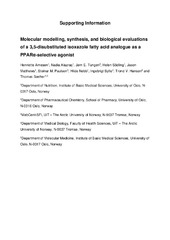| dc.contributor.author | Arnesen, Henriette | |
| dc.contributor.author | Haj-Yasein, Nadia N. | |
| dc.contributor.author | Tungen, Jørn E. | |
| dc.contributor.author | Soedling, Helen | |
| dc.contributor.author | Matthews, Jason | |
| dc.contributor.author | Paulsen, Steinar M. | |
| dc.contributor.author | Nebb, Hilde I. | |
| dc.contributor.author | Sylte, Ingebrigt | |
| dc.contributor.author | Hansen, Trond Vidar | |
| dc.contributor.author | Sæther, Thomas | |
| dc.date.accessioned | 2019-09-03T10:36:47Z | |
| dc.date.available | 2019-09-03T10:36:47Z | |
| dc.date.issued | 2019-07-19 | |
| dc.description.abstract | The peroxisome proliferator activated receptors (PPARs) are important drug targets in treatment of metabolic and inflammatory disorders. Fibrates, acting as PPARα agonists, have been widely used lipid-lowering agents for decades. However, the currently available PPARα targeting agents show low subtype-specificity and consequently a search for more potent agonists have emerged. In this study, previously isolated oxohexadecenoic acids from the marine algae <i>Chaetoceros karianus</i> were used to design a PPARα-specific analogue. Herein we report the design, synthesis, molecular modelling studies and biological evaluations of the novel 3,5-disubstituted isoxazole analogue 6-(5-heptyl-1,2-oxazol-3-yl)hexanoic acid (<b>1</b>), named ADAM. ADAM shows a clear receptor preference and significant dose-dependent activation of PPARα (EC<sub>50</sub> = 47 µM) through its ligand-binding domain (LBD). Moreover, ADAM induces expression of important PPARα target genes, such as <i>CPT1A</i>, in the Huh7 cell line and primary mouse hepatocytes. In addition, ADAM exhibits a moderate ability to regulate PPARγ target genes and drive adipogenesis. Molecular modelling studies indicated that ADAM docks its carboxyl group into opposite ends of the PPARα and -γ LBD. ADAM interacts with the receptor-activating polar network of amino acids (Tyr501, His447 and Ser317) in PPARα, but not in PPARγ LBD. This may explain the lack of PPARγ agonism, and argues for a PPARα-dependent adipogenic function. Such compounds are of interest towards developing new lipid-lowering remedies. | en_US |
| dc.description.sponsorship | FRIPRO-FRINATEK 230,470 | en_US |
| dc.description | Source at <a href=https://doi.org/10.1016/j.bmc.2019.07.032>https://doi.org/10.1016/j.bmc.2019.07.032. </a> | en_US |
| dc.identifier.citation | Arnesen, H., Haj-Yasein, N.N., Tungen, J.T., Soedling, H., Matthews, J., Paulsen, S.M. ... Sæther, T. (2019). Molecular modelling, synthesis, and biological evaluations of a 3,5-disubstituted isoxazole fatty acid analogue as a PPARα-selective agonist. <i>Bioorganic & Medicinal Chemistry, 27</i>(18), 4059-4068. https://doi.org/10.1016/j.bmc.2019.07.032 | en_US |
| dc.identifier.cristinID | FRIDAID 1718462 | |
| dc.identifier.doi | 10.1016/j.bmc.2019.07.032 | |
| dc.identifier.issn | 0968-0896 | |
| dc.identifier.issn | 1464-3391 | |
| dc.identifier.uri | https://hdl.handle.net/10037/16078 | |
| dc.language.iso | eng | en_US |
| dc.publisher | Elsevier | en_US |
| dc.relation.journal | Bioorganic & Medicinal Chemistry | |
| dc.relation.projectID | info:eu-repo/grantAgreement/RCN/BIOTEK2021/208452/Norway/Nuclear receptor ligands from Arctic marine organisms; Bioprospecting, structure, synthesis and evaluation as drug to treat metabolic syndro// | en_US |
| dc.rights.accessRights | openAccess | en_US |
| dc.subject | VDP::Medical disciplines: 700::Basic medical, dental and veterinary science disciplines: 710 | en_US |
| dc.subject | VDP::Medisinske Fag: 700::Basale medisinske, odontologiske og veterinærmedisinske fag: 710 | en_US |
| dc.subject | Peroxisome proliferator activated receptor | en_US |
| dc.subject | Agonist | en_US |
| dc.subject | Oxohexadecenoic acid | en_US |
| dc.subject | Isoxazole | en_US |
| dc.subject | Lipid-lowering | en_US |
| dc.subject | Microalgae | en_US |
| dc.subject | Chaetoceros karianus | en_US |
| dc.title | Molecular modelling, synthesis, and biological evaluations of a 3,5-disubstituted isoxazole fatty acid analogue as a PPARα-selective agonist | en_US |
| dc.type | Journal article | en_US |
| dc.type | Tidsskriftartikkel | en_US |
| dc.type | Peer reviewed | en_US |


 English
English norsk
norsk
